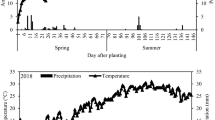Abstract
Crop response to deficit irrigation is an important consideration for establishing irrigation management strategies when water supplies are limited. This study evaluated the response of native spearmint to water deficits applied using overhead sprinklers in eastern Washington, US. Five levels of irrigation were applied ranging from full irrigation (100%) to 5% of weekly averaged full crop water needs. Soil water monitoring with soil water balance was used to estimate soil water deficits for irrigation scheduling and soil water use. Mint oil yields, oil components, dry matter production, and the water-use efficiency of the spearmint were assessed. There was significant reduction in fresh mint hay (harvested biomass) yield with increasing water deficit. However, spearmint oil yields remained generally uniform across irrigation treatments at the first cutting but decreased at the driest plots during the second harvest due to a loss of plant stand. The wet harvest index and water-use efficiency improved significantly for both harvests with increasing water deficit. Hay yield, oil yield, wet harvest index, and water-use efficiency are pooled across sides and replicate blocks to provide trends with changes in maximum evapotranspiration. The three major monoterpenes show changes suggesting less mature oil yields. The study demonstrates the feasibility of sustaining native spearmint yields under managed deficit irrigations for deficits not lower than 0.5 ETc.







Similar content being viewed by others
References
Charles DJ, Jolly RJ, Simon JE (1990) Effects of osmotic stress on the essential oil content and composition of peppermint. Phytochemistry 29(9):2837–2840
Delfine S, Loreto F, Pinelli P, Tognetti R, Alvino A (2005) Isoprenoids content and photosynthetic limitations in rosemary and spearmint plants under water stress. Agric Ecosyst Environ 106:243–252
English M (1990) Deficit irrigation. I. Analytical framework. J Irrig Drain Eng 116:399–412
English M, Raja SN (1996) Perspectives on deficit irrigation. Agric Water Manag 32:1–14
Fereres E, Soriano MA (2007) Deficit irrigation for reducing agricultural water use. Integrated approaches to sustain and improve plant production under drought stress. J Exp Bot 58:147–159
Geerts S, Raes D (2009) Deficit irrigation as an on-farm strategy to maximize crop water productivity in dry areas. Agric Water Manag 96:1275–1284
Geerts S, Raes D, Garcia M, Condori O, Mamani J, Miranda R, Cusicanqui J, Taboada C, Vacher J (2008) Could deficit irrigation be a sustainable practice for quinoa (chenopodium quinoa wild) in the southern Bolivian Altiplano? Agric Water Manag 95:909–917
Hanks RJ, Keller J, Rasmussen VP, Wilson GD (1976) Line source sprinkler for continuous variable irrigation. Crop production studies. Soil Sci Am Proc 40:426–429
Hanks RJ, Sisson DV, Hurst RL, Hubbard KG (1980) Statistical analysis of results from irrigation experiments using the line-source sprinkler system. Soil Sci Am J 44:886–888
Hsiao T, Steduto P, Fereres E (2007) A systematic and quantitative approach to improve water use efficiency in agriculture. Irrig Sci 25:209–231
Kaman H, Kirda C, Cetin M, Topcu S (2006) Salt accumulation in the root zones of tomato and cotton irrigated with partial root-drying technique. Irrig Drain 55:533–544
Kijne JW, Barker R, Molden DJ (2003) Water productivity in agriculture: limits and opportunities for improvement. Wallingford, UK
Mitchell AR, Yang CL (1998) Irrigation of peppermint for optimal yield. Soil Sci Soc Am J 62:1405–1409
Molden D (2003) A water-productivity framework for understanding and action. In: Kijne JW, Barker R, Molden D (eds) Water productivity in agriculture: limits and opportunities for improvement. International Water Management Institute, Colombo, pp 1–18
Okwany RO, Peters TR, Ringer KL (2009) Effect of sustained deficit irrigation on hay and oil yield of native spearmint (Mentha spicata). In irrigation and drainage for food, energy and the environment. In: 5th international conference on irrigation and drainage, Salt Lake City, Nov 3–6, pp 239–252
Pereira LS, Oweis T, Zairi A (2002) Irrigation management under water scarcity. Agric Water Manag 57:175–206
Pollack S (1995) Peppermint and spearmint: an economic assessment of the feasibility of providing multiple-peril crop insurance. Economic Research Service, USDA. Consolidated farm service agency, office of risk management
Ragab R (1996) Constraints and applicability of irrigation scheduling under limited water resources, variable rainfall and saline conditions. In: United Nations (FAO) (ed) Food and Agricultural Organization of the United Nations (FAO). Irrigation scheduling: from theory to practice. Rome, pp 149–165
Sarwar A, Bastiaanssen WGM (2001) Long-term effects of irrigation water conservation on crop production and environment in semiarid areas. J Irrig Drain Eng 127:331–338
Schoups G, Hopmans JW, Young CA, Vrugt JA, Wallender WW, Tanji KK, Panday S (2005) Sustainability of irrigated agriculture in the San Joaquin Valley, California. Proc Natl Acad Sci USA 102:5352–15356
WSCPR (2008) Spearmint (native). The compendium of Washington agriculture. WSCPR. org. http://69.93.14.225/wscpr/LibraryDocs/SpearmintNative2010.pdf. Accessed 2 June 2008
Zhang H, Oweis T (1999) Water-yield relations and optimal irrigation scheduling of wheat in the Mediterranean region. Agric Water Manag 38:195–211
Zwart SJ, Bastiaanssen WGM (2004) Review of measured crop water productivity values for irrigated wheat, rice, cotton and maize. Agric Water Manag 69:115–133
Acknowledgments
The authors would like to thank the Washington Mint Commission for its financial support to the project. Special acknowledgments to Ray Baker and Dr. Moumita Chakraborty for their assistance with fieldwork and lab-work respectively.
Author information
Authors and Affiliations
Corresponding author
Additional information
Communicated by A. Kassam.
Rights and permissions
About this article
Cite this article
Okwany, R.O., Peters, T.R., Ringer, K.L. et al. Impact of sustained deficit irrigation on spearmint (Mentha spicata L.) biomass production, oil yield, and oil quality. Irrig Sci 30, 213–219 (2012). https://doi.org/10.1007/s00271-011-0282-4
Received:
Accepted:
Published:
Issue Date:
DOI: https://doi.org/10.1007/s00271-011-0282-4




